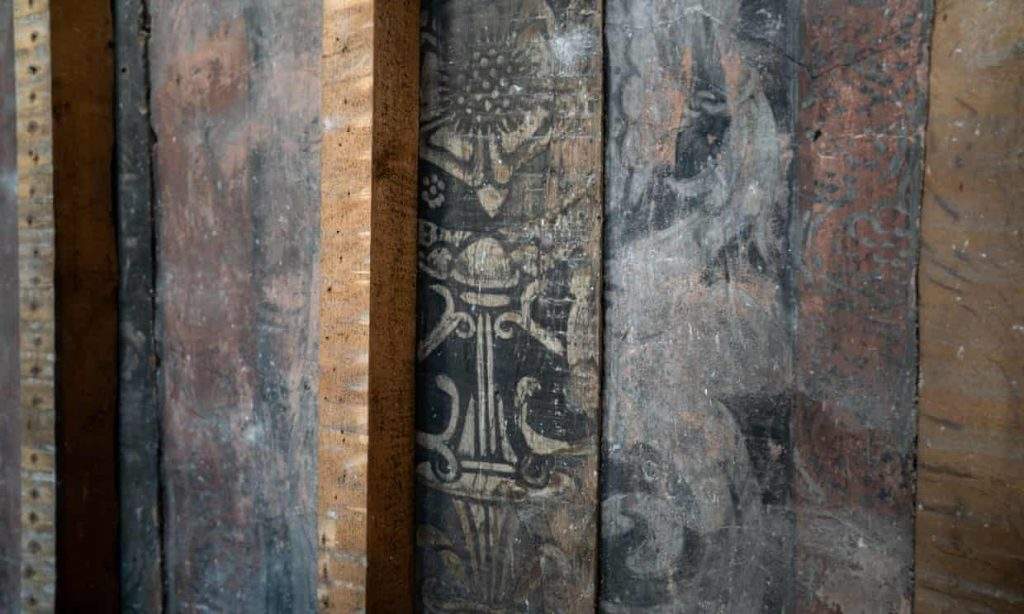England, miraculous discovery in Leeds: Elizabethan-era decorations unearthed
An important discovery in England: in the manor of Calverley Old Hall near Leeds, an ancient mansion whose history begins in the 12th century (it was later remodeled in the following centuries and, starting in the 14th century, was the residence of the Calverley family for five centuries), some wall paintings have in fact been discovered that date back to the Tudor era, that is, to the second half of the 16th century, and to be precise to the time of Elizabeth I. The paintings were concealed under 19th-century plaster and were discovered during some routine maintenance work. The announcement was made by The Landmark Trust, the body that runs Calverley Old Hall, and according to its director, Anna Keay, it is the “discovery of a lifetime” (so she told the Guardian).
The paintings occupy three walls of the room (it was a bedroom), and it is, explained art historian Caroline Stanford, a very rare occurrence: it is difficult to find decorations of the period, of this type and so extensive, in a private home in northern England. But most interesting, the scholar reported, is that among the decorations also appear some grotesques, far more sophisticated than any other wall decoration that has been found in the past in similar contexts in this geographical area. The Calverleys were, after all, an educated family, eager to display their knowledge and wealth even through their appreciation of Renaissance culture. Grotesques, typical of the Italian Renaissance, began to spread much later in England, and so the question is how such a motif came to northern England in the mid-sixteenth century.
Certainly at the court of Henry VIII, the Italian Renaissance was known and appreciated: there are examples of buildings, some of which are also managed by The Landmark Trust, that take up motifs (especially architectural ones) typical of Italy. This taste continued to spread even following the Italian schism, especially thanks to the spread of prints and engravings produced especially by artists from the German and Dutch areas: illustrated books circulated widely not only among patrons and the educated classes, but also among artisans, who used motifs from abroad as decorations for furniture, gold and silver plates, jewelry, embroidery, and interior decoration. It was probably from such printed books that the anonymous Calverley Old Hall artist drew inspiration for his decoration.
The paintings, Stanford explained, appear very carefully planned. The walls are decorated with animal and plant motifs, as well as fantastic figures and architectural elements. Around the frame then runs a frieze of roses and pomegranates: a pomegranate was an emblem originally associated with Henry VIII’s first wife, Catherine of Aragon, and thus with his Catholic faith, and this symbol therefore had some significance for the Calverleys who were Catholics. As mentioned above, there are three painted walls but it is likely that originally the whole room (a bedroom) was decorated.
Dendrochronological examinations suggest that the roofs of the room where the paintings were found were built in 1514-39. Two construction phases can be distinguished in the room, while its floor was inserted later, between 1547 and 1585. This is a very wide range that covers several events: the exact date of the paintings’ completion is unknown, but it is likely that they date from the mid-sixteenth century. The most likely patron of these paintings is Sir William Calverley (c. 1500 - 1572). William Calverley was knighted in 1548 and became sheriff of York in 1549: he was therefore a man of high rank. It is plausible, Stanford explained, that the setting was Sir William’s private chamber, where he entertained only his closest friends and associates, but it could also be the private sitting room of Elizabeth Sneyd, Sir William’s wife.
“We have developed a specialized program of investigations and conservation recommendations, and we may find out more about the origins of the paintings,” Stanford concludes. “What is already clear is that The Landmark Trust must find a way to preserve and, if possible, show the public this miraculous survival from the Elizabethan age, a discovery that so magically transforms our appreciation of what life was like at this ancient site.”
Pictured: some of the found decorations.
 |
| England, miraculous discovery in Leeds: Elizabethan-era decorations unearthed |
Warning: the translation into English of the original Italian article was created using automatic tools. We undertake to review all articles, but we do not guarantee the total absence of inaccuracies in the translation due to the program. You can find the original by clicking on the ITA button. If you find any mistake,please contact us.




























